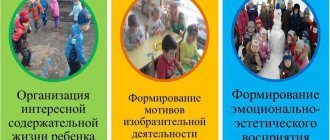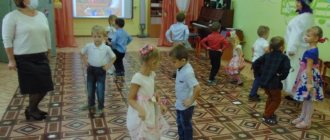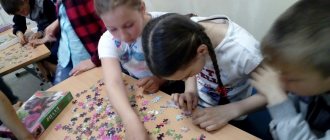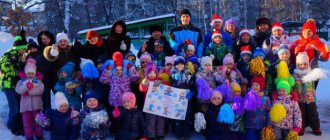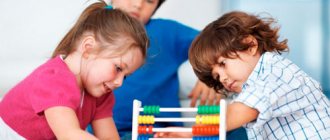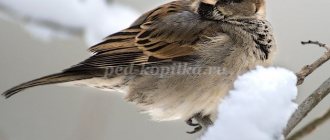Sports in kindergarten
Sport is an essential component of every person’s life. Sports are no less important for children, including the youngest. It is necessary to instill in a child a love of sports from childhood, and the most important example for him, of course, is his parents.
Sports in kindergarten
Kindergarten is an active part of a child’s life. Coming every day to kindergarten, to a group of children, the child will learn discipline and a certain daily routine. Sports activities are necessarily included in the main kindergarten schedule. Morning exercises, sports competitions, sports festivals are the key moments necessary to accustom a child to sports from childhood.
Note: a useful section on the topic of sports in kindergarten in the educational toy store “Kindergarten”. Children's sports equipment for preschoolers.
Sports and game
Of course, you shouldn’t force a love of sports on children, especially young ones, in kindergarten. A love of physical activity should be instilled gradually and always in a playful way. Elements of competition, relay races and simply active games that can be played in the gym or in the fresh air help well in this matter.
It is also necessary for the teacher to actively participate in sports games, along with the children, thereby setting an example. Children love to follow the example of adults who are in their immediate environment. Teachers and parents become the main role models. Sports in kindergarten is the work of both adults and children.
Sports competitions
The element of competition between children is very important in kindergarten sports. You can arrange fun relay races with bright elements, for example, colorful balls, skittles, rings, jump ropes. Bright colors not only relieve the atmosphere, but also make the sport bright and interesting.
However, educators must explain to children that winning is not as important as participation in the game and team spirit.
The teacher can also tell the children about the emergence of sports competitions, for example, about the Olympic Games, which became an alternative to the war that lasted for many years. A plus will be a story about the benefits of sport, its impact on physical development and human health. The child must understand that sport is not only a compulsory activity, but also a system for healing the body.
Sports and health holidays
Organizing sports holidays in kindergarten and health holidays will also help to instill in children a love of sports, because a holiday is a holiday and it doesn’t matter at all what the reason for it will be.
There are many scenarios for holding this kind of holiday, and in addition to the usual relay races and competitions, you can organize a sports quiz or an exhibition of children's drawings on the topic of sports and health. Little artists will definitely be inspired by the theme and will try to translate their thoughts onto paper. You will find some scenarios dedicated to sports in kindergarten on our website.
Note to parents
It’s not just teachers who instill in children a love of sports. Parents should also actively participate in the child’s life and explain to him the need for physical activity. Sports should be present not only in kindergarten, but also at home!
For example: you can explain to a child that if he plays sports, runs, jumps and does exercises, he will become healthier and will be able to avoid illnesses, bitter medicines and injections.
Together with your child, you can come up with a story about the insidious Flu and Sports, who was able to defeat the disease thanks to his strength.
You need to instill a love of sports in a fun and relaxed way. In winter, it is useful to go skiing with your child, and you can do gymnastics at home. Of course, sports should be a must in kindergarten!
Little children love it when adults ask them to teach them how to do exercises that they learned in kindergarten. At such moments, children feel more authoritative and willingly teach their parents simple exercises. However, it is important not to interrupt the child and repeat all his movements exactly, then the baby will be happy, and the sport will become a pleasant pastime for him.
Author Natalya Shumaeva.
Didactic manual “Types of sports”
Tasks:
- Consolidate knowledge about sports;
- Learn to establish the simplest relationships between a sport and its attributes, the time of year;
- To develop the ability to speak correctly and completely and actively use words in speech on the topic “Sports Games”;
- Improve communication skills.
- Cultivate perseverance, patience, diligence.
Description of the manual: The versatility of the didactic manual “Types of Sports”, with a set of pictures on lexical topics: “Winter Sports”, “Summer Sports”, “Sports Equipment for an Athlete”, “Symbols of Sports Games” suggests the possibility of its use in working with children senior preschool age. When creating the manual, I proceeded from the fact that it should be bright, attractive for children, educational, developing, convenient, so that several children could play at the same time. By varying the playing fields with tasks and ways to complete them, you can maintain interest in preschoolers for a long time. The manual allows you to consolidate material from simple to more complex.
The manual is made of plates covered with colored paper. The pockets are made of transparent film. Cards with types of sports, attributes for sports games, symbols of sports games are printed on a printer. Three plates connected to each other (like Lull circles). Several circles of different diameters are strung on a rod. All circles are divided into the same number of sectors. There are pictures on them. The circles move freely. Removable circles can be combined with other illustrations depending on the purpose. Using just a few rings, you can get either different versions of the game or additions to the game being played.
Method of operation: To start the game, place the manual on the table. Place the selected rings with pictures on top of the circles. Unscrew the edges of the plates. There are many game options. It all depends on the tasks assigned and the material covered by the children. The circles are divided into sectors and a picture is glued to each one, or the children insert them into the pockets themselves. Children, rotating the plates, must match the pictures united by the general theme of the game. This manual can be used to compose stories - a description of a sport (skiing, gymnastics, basketball, volleyball) using reference pictures - diagrams (a story in a chain, a story by two (three) children, one child). To reinforce the material, you can play a didactic game “Find the mistake”, in which the teacher swaps the pictures in advance, and the children find a picture that does not correspond to the signs of a given time of year. You can use the manual in the following educational games:
Game "Pick up a picture"
Goal: To consolidate children's knowledge about different sports; teach children to identify the signs of sports games; develop the ability to analyze and generalize; develop creative thinking and imagination; to develop children's interest in physical education and sports.
Game description: Pictures of winter and summer sports (hockey, luge, ski jumping, gymnastics, swimming, tennis, athletics, cross-country skiing) are attached to the bottom ring. Children select pictures and put them in pockets. Winter sports are placed on the blue sectors, and summer sports on the yellow sectors. For the top ring, select the appropriate attribute for it (team, single sport, etc.)
For example: on the lower ring - an image of a hockey player is attached, on the upper ring - a team sport
Complication : Sports are selected after solving the riddle.
To consolidate the material, you can play the didactic game “Find the mistake”, in which the teacher changes the pictures in places, and the children find a picture that does not correspond to the sports game.
Puzzles
They chase the ball around the court with rackets, then they hit it, then they don’t have time to catch up . (Tennis)
The athlete rushes down the slope like an arrow. The snow flows like a fountain from the skis, deftly goes around the gate, and develops great speed. (Skier)
At the stadium, running, walking, jumping, throwing, what is the correct name for the competition? (Athletics)
Our aces are swimming along the water paths, now butterfly, now crawl, now breaststroke. (Swimming)
He climbed the springboard and was not afraid of heights. He put on his skis, flew off the springboard, landed on the ground, did not fall, did not crash. Who is this? (Ski jumper)
The athlete accelerates while sitting on them, and lies down on his back. (luge)
The game is on at the skating rink, the ice is hot with skates. Two teams perform, the puck is kicked with sticks. Hey guys, have fun. And this game... (Hockey).
These fragile dragonflies are virtuosos with a skipping rope, They control hoops, clubs and balls, They can draw with a ribbon, Who are they I want to know? (Gymnasts)
"Find a Pair"
Goals and objectives: to develop children’s interest in physical education and sports; introduce children to sports; teach children to recognize the symbols of sports games.
Game description: Children must match the cards with sports and their symbols.
To reinforce the material, you can play the didactic game “Find the Error,” in which the teacher swaps the pictures in advance, and the children find a picture that does not match.
“Guess whose balls?”
Target. Strengthen children's knowledge about different sports, athletes, sports attributes; teach children to recognize and name sports equipment; develop visual attention and logical thinking; expanding children's vocabulary with adjectives; develop interest and love for sports.
Description of the game: Children name any sport on the lower ring, then by moving the middle and upper rings they select the sport, the corresponding definition and the ball belonging to this game.
For example: On the bottom ring they name the sport - basketball, the athlete is a basketball player, on the middle ring they call a basketball hoop and correlate the top ring with the symbol of this game.
At the end, children can be asked questions to consolidate:
– Show which athletes play football, tennis, basketball, rugby, volleyball.
– Men and women go in for sports. A man playing football is a footballer, but a woman? (ask about tennis, basketball, rugby, volleyball)
“Each player has his own field”
Target. Strengthen children's knowledge about different sports, athletes, sports grounds; develop visual attention and logical thinking; develop interest and love for sports.
Description of the game: Children guess riddles (type of sport), insert them into the pockets of the lower ring, then select a sports ground corresponding to this sports game into the pockets of the upper ring
Puzzles
A successful pass results in a goal! What is the name of the game? (Football)
Two comrades fight in shorts and warm mittens (Boxing)
The defense doesn’t sleep, we go on the attack, approaching the shield, putting the ball in the basket. (Basketball)
Hit the puck accurately with your stick, since you play ... (Hockey)
“Who owns what?”
Goals and objectives: to develop children’s interest in physical education and sports; introduce children to sports; teach children to define sports games and correlate their games with symbols; develop the ability to analyze and generalize; develop creative thinking and imagination.
Description of the game: Children guess riddles (type of sport) on the lower ring, then by moving the middle and upper ring they select the sport, the corresponding definition and symbol of the sports game.
Puzzles
The wheels are spinning, the spokes are sparkling, and the road racers are racing in a chariot . (Cycling)
At the stadium, running, walking, jumping, throwing, what is the correct name for the competition? (Athletics)
Our aces are swimming along the water paths, now butterfly, now crawl, now breaststroke. (Swimming)
Exercises on uneven bars, pommel horse and beam, These young athletes are quite capable . (Gymnasts)
They pulled the bowstring, The arrows were released... Oooh They flew, didn’t fall, They hit the bull’s eye straight . (Archery)
A successful pass results in a goal! What is the name of the game? (Football)
Two comrades fight in shorts and warm mittens (Boxing)
Our horse rushes to the finish line. What is that game called (Equestrian sport)
"Sport equipment"
Target. Strengthen children's knowledge about different sports, athletes, sports attributes; teach children to recognize and name sports equipment, determine its purpose; Develop visual attention and logical thinking.
Game description: Pictures of winter and summer sports (figure skating, cycling, speed skating, basketball, football, snowboarding, boxing, alpine skiing) are attached to the bottom ring. Children select pictures and put them in pockets. On the middle ring, too, after solving the riddle, the appropriate equipment is selected for it (boxing gloves, snowboard, skates, soccer ball, skis, basketball hoop, bicycle), on the upper ring signs of sports are indicated (summer or winter sports)
For example: an image of a hockey player is attached to the bottom ring, a stick to the middle ring, a snowflake to the top ring (winter sport)
After all the circles have been collected, the children determine which athlete needs these items.
Skis are needed... (skier). Skates are needed (for a figure skater, speed skater). A ball is needed (for a football player, a basketball player). A snowboard is needed (for a snowboarder),
Boxing gloves are needed (for a boxer)
A bicycle is needed (A cyclist)
Puzzles
Riddles for the bottom ring
The defense doesn’t sleep, we go on the attack, approaching the shield, putting the ball in the basket. (Basketball)
So they came together in a fight in the ring. Everyone has gloves on their hands. The cheerful gong sounded and gave the signal for the start of the battle . (Boxing)
The hero rushes along a steep mountain, He is not afraid of frost, The speed is like that of a steam locomotive . (Skier)
The wheels are spinning, the spokes are sparkling, and the road racers are racing in a chariot . (Cycling)
Skates glide swiftly along the ice path. Athletes want to surpass each other. (Skating).
Jumping, lifting and spinning on the ice to the music. The runners on the skates are shiny, the costumes are a sight to behold. (Figure skating)
A successful pass results in a goal! What is the name of the game? (Football)
Over snow-capped mountains, over jumps and hills, on the “snowboard” apparatus, athletes beat their records. (Snowdording)
Riddles for the middle ring
From the blows, I take off and fly into the distance at full speed. I love flying into the gate, hearing the joyful “Goal!” My only concern is to make football beautiful. I don’t like it when people touch me with their hands sometimes. You can tame me with your feet or with your head. (Soccer ball)
Who will catch up with me on the ice? We are running the race! And it’s not horses that carry me, but shiny ones ... (Skates)
Early in the morning along the road, dew glistens on the grass, feet ride along the road and two wheels run. The riddle has an answer - This is my... (Bicycle)
There are two stripes in the snow, Two foxes were surprised. One came closer: Someone was running here... (Skis)
It looks like just a board, But it’s proud of its name, It’s called... (Snowboard)
The ball cracks when hit. It will be scored into it (Basketball hoop)
Two girlfriends are leather pillows, they dress on their hands, they fight in the ring. (Boxing gloves)
"Winter and summer sports"
Goal: To introduce children to winter and summer sports and consolidate existing ideas about them. Learn to solve riddles using evidence-based speech. Develop interest and love for sports.
Description of the game: Players sort out cards with images of attributes. The teacher reads the riddle, the players guess and select the necessary pictures, putting them in their pockets.
Puzzles
They chase the ball around the court with rackets, then they hit it, then they don’t have time to catch up. (Tennis)
The athlete rushes down the slope like an arrow. The snow flows like a fountain from the skis, deftly goes around the gate, and develops great speed. (Skier)
Players fight for the ball: Attack, defend, Take aim at the goal From the left, from the right, from a turn. They score a goal and shout: “Hurray!” But the game is played in the pool, not on the field. And it's called (Water polo)
Skates glide swiftly along the ice path. Athletes want to surpass each other. (Skating).
At the stadium, running, walking, jumping, throwing, what is the correct name for the competition? (Athletics)
Here are the boats running, Right and left, here and there, People control them, Walking with the wind on the waves. (Sailing)
He climbed the springboard and was not afraid of heights. He put on his skis, flew off the springboard, landed on the ground, didn’t fall, didn’t crash. Who is it? (Ski jumper)
The athlete approaches the barbell and takes it by the bar. The projectile swings forward and back, And now the projectile is at the top - the weight is taken. (Weightlifting)
Jumping, lifting and spinning on the ice to the music. The runners on the skates are shiny, the costumes are a sight to behold. (Figure skating)
These fragile dragonflies are virtuosos with a skipping rope, They control hoops, clubs and balls, They can draw with a ribbon, Who are they I want to know? (Gymnasts)
Two opponents in a fight fight: They attack and fight back. There is no blood from a rapier injection. At least there are tournaments with battles. (Fencing)
In this sport, the players are all agile and tall. They love to play with the ball and throw it into the hoop. The ball hits the floor loudly, So this is... (Basketball)
I’m in a hurry to go to training, I fight deftly in a kimano. I need a black belt, Because I love..... (Karate)
Who is steeper? Slightly noticeable Toward the cloud, to the cloud, Meter by meter Rising with difficulty - Carrying his house on his back? Think, think, don't be lazy! Not a snail - ... (Climber)
Basic rules of fitness in kindergarten
Children's fitness must be divided into age groups. A number of exercises for older preschoolers are not suitable for toddlers. It is also necessary to allocate different times for studying. For example, for younger kindergarteners, training should not last more than 20-25 minutes; in the middle group, training can last half an hour, and in the older group - 35 minutes.
Classes must be conducted under the supervision of a teacher. Before training, it is necessary to check the well-being of the participants and make sure that they have changed into sportswear and shoes.
Post Views: 10,077
Types of sports elements in kindergarten
Conventionally, the sports load in kindergarten can be divided into the following categories:
- General developmental exercises in kindergarten are based on a set of developmental tasks. This may include:
- morning exercises;
- breathing practice;
- ball exercises;
- tasks for different types of motor activity with and without different objects;
- movements with a hoop.
- Health-improving exercisesAimed at improving and strengthening the body of a preschool child. Here we can highlight:
- elements for the prevention of flat feet;
- stretching exercises;
- hardening procedures, barefoot physical education;
- visiting the swimming pool;
- elements to strengthen the muscles of the back and abdomen.
- Dance and sports directionHelps to identify the child’s inclinations for one or another type of sports activity. In kindergarten you can find:
- rhythmoplasty;
- aerobics;
- gymnastics
- Play activitiesThis includes everything that helps preschoolers develop physically through play:
- football;
- basketball;
- volleyball;
- team games;
- competitive games.
It is also worth setting aside time for children to independently master sports elements. This usually happens outdoors, on a playground with slides, swings, etc., or indoors, where there is a sports corner with additional hanging equipment.
General developmental exercises in kindergarten
Depending on the goal, you can develop various sets of general developmental exercises for children of different ages. Morning exercises or physical education, breathing practice or elements with a hoop, exercises with balls or other objects. You can come up with your own program for both toddlers and older children.
Physical complex for morning exercises
The following set of exercises can be suggested as morning exercises:
- Stretch Children stand in a circle, rise on their toes and stretch upward with straight arms. With an exhalation, the arms return to the starting position through the sides, the soles of the feet fully touch the floor. You can do it on the spot, or you can take a step to the side, moving between the stretches in a circle.
- Pendulum You can also form a circle, stand with your feet shoulder-width apart, and place your hands on your waist. Do versatile head tilts.
- Doll We include the shoulders in the work. To do this, place your arms along your body. Raise your right shoulder first, then your left.
- Tumbler We sit on the floor, pull our legs towards ourselves and clasp them with our hands. From this position we do versatile rolls.
- Top We stand on our feet, placing them shoulder-width apart. We jump on two legs, alternating jumping with walking. You can alternate elements in a circular motion.
Breathing practice
It is important to teach kindergarteners to do breathing practice. It is necessary after each set of exercises. In addition, this practice is an excellent prevention of diseases of the throat and nose.
To stir up interest, you can give each element a fun name, for example:
- We blow bubbles - take a deep breath through our nose, puffing out our cheeks, then slowly exhale through our slightly open mouth.
- Pump - we stand up and put our hands on our belts, inhale and squat a little, and exhale we straighten up. The goal is to gradually make your squats lower and your inhalations and exhalations deeper.
- Chicken - we stand up and bend down, hanging our arms freely, playing the role of wings, and lowering our head. With an exhalation, we pat ourselves on the knees and say “so-so-so”, with an inhalation we straighten up and raise our arms up.
- Watch - stand up straight, feet shoulder-width apart, arms down. We swing our straight arms back and forth, while saying “tick-tock.”
- Trumpeter - sit down and fold your raised hands into a tube. While exhaling slowly we say “p-f-f”.
Movements with the ball
With the ball you can also come up with a huge number of exercises for different kindergarten groups:
- standing, we take the ball in both hands and lower them down, lifting the ball over our heads while rising on our toes;
- we transfer the ball from one straight hand to another in the starting position - standing, feet shoulder-width apart, arms to the sides, the ball is in one of the hands;
- we sit on the floor, crossing our legs, placing the ball on the right side of the floor, rolling the ball in front of us in the other direction;
- we jump on two legs with a ball in our hands;
- we throw the ball up, throw it from one hand to the other.
A complex of different elements with and without objects
- With cubes
- We stand with feet shoulder-width apart, arms along the body, cubes in hands. We raise our arms up from the sides and knock the cubes against each other.
- We sit on the floor, take the cubes in our hands and bend them at the elbows. Raise your legs up and hit the cubes under your knees.
- We jump with cubes, spreading our arms in different directions.
- With checkboxes
- We stand up, spread our arms with flags to the sides. We make lunges, touching the hand with the flag to the knee of the same leg.
- We spread our legs wide, stretch our arms forward with the flags. We turn to one side, moving our hand back and following the flag with our eyes. Repeat with the other hand.
- The starting position is the same, we raise our hands with flags up. We bend down, the flags stretch to the floor.
- No items
- Feet shoulder-width apart, arms along the body. We rise on our toes, raising our right arm up. Repeat with the other hand.
- We squat down and hug our knees with our hands. We straighten up, standing on our tiptoes and raising our arms up.
- We lie on the floor on our backs with straight legs and arms located along the body. We clasp our head with our hands and press it to our knees pulled up to our stomach. We curl up into a ball in this way.
Movements with a hoop
A hoop can also diversify children's fitness, adding interest and benefit to exercise:
- We stand up and hold the hoop below. Raise the hoop forward, then up, then forward and down again.
- Feet shoulder-width apart, clasp the hoop on the sides and press it to the chest. We turn the body in one direction, extend straight arms in the same direction. Repeat on the other side.
- The starting position is the same. We squat, bringing the hoop forward.
- Keep the hoop down. We lift it forward and bend over, looking into the hoop. We linger for a few seconds in this position. The back is straight.
- We stand near the hoop. We begin to jump around the inventory.
Wellness practice
Health-improving exercises play a huge role in fitness for preschoolers. After all, the groundwork for the rest of your life is laid precisely from childhood. Particular attention here should be paid to exercises that prevent the development of flat feet, stretching and strengthening elements.
Elements that prevent flat feet
The foot is the foundation of the entire body, so flat feet should not be taken lightly. And if we take into account that the formation of the musculoskeletal system occurs over a period of up to 6 years, then it is recommended to prevent flat feet at this age.
We offer the following set of exercises aimed at preventing flat feet:
- We sit on a chair, place a massage ball under one foot and roll it back and forth and in a circle. Repeat with the other leg. The back is straight.
- We squat in a frog pose, hands on knees, heels together:
- we press our hands on our knees and connect them together;
- we rest our hands on the floor behind our backs and, sliding the outside of our feet, bend and straighten our legs;
- Raise your legs and start tapping your feet.
- We sit on a chair with a straight back, holding its edge with our hands:
- We place our feet one by one on the heels;
- we walk on our toes back and forth;
- we take a handkerchief and try to grab it with one foot;
- transfer the scarf from one foot to the other.
- The starting position is the same. Hands on the belt. Draw a circle on the floor with the toe of one foot. Repeat with the other leg.
- We sit on the floor, arms supported behind us, legs bent, feet together, back straight. We raise our legs and press our feet into each other.
- The starting position is the same. We alternately draw pictures in the air with our toes.
Important! The entire complex is carried out without shoes, additionally providing hardening.
Stretching in kindergarten
Stretching is designed to gently stretch the muscles. In order for the elements to be performed smoothly, without jerks, calm music is used in kindergarten.
The training complex can include the following stretching elements:
- we stand up, arms along the body, toes in different directions, heels next to each other - we rise onto our toes with straight arms, stretching upward as much as possible;
- the starting position is the same - when lifting, we stretch our arms in different directions, fixing ourselves in this position;
- feet parallel, legs at shoulder level - raise our arms and sit down without lifting our feet from the floor;
- lie on the floor on your stomach, clasp your ankles with your hands, raise your head and raise your shoulders and chest, if possible, raise your stomach;
- the starting position is the same, arms along the body, legs straight - bend one leg, leaving the foot on the floor, repeat with the other leg.
Elements for strengthening the muscles of the back and abdomen
You can strengthen your core muscles in kindergarten using exercise equipment such as a horizontal bar, fitball, health discs, expanders, and abdominal benches.
The following elements perform well:
- hanging on the horizontal bar - stretches the back, simultaneously strengthening it;
- pull-ups on the horizontal bar and hanging leg raises;
- passing a fitball while lying on your back from your arms to your legs and vice versa;
- crunches on a fitball or abdominal bench;
- gluteal bridge on a fitball and so on.
And if a wall bars with attachments are installed in the kindergarten, then there should be no problems with strengthening training at all. Preschoolers themselves will find activities to their liking, using the hanging equipment to their advantage.
Dance and sports direction
This is probably the most interesting area of fitness in kindergarten. Thus, the following types of activities can be distinguished:
- Aerobics Includes all aerobic elements that fill the body with oxygen. Dancing movements, jumping, running - all these cyclical movements stimulate the functioning of the cardiac and respiratory systems and give a great mood.
- Rhythmic gymnastics A variation of the usual gymnastics, but with an emphasis on intense motor activity. A wide range of movements helps improve coordination abilities and motor memory.
- Logorhythmics A very interesting direction that combines physical elements with the pronunciation of sounds and their derivatives. Here, in addition to physical development, speech development occurs.
- Animal aerobics Another type of activity, fun and entertaining, combines aerobics with movements that imitate the behavior of animals.
- Step aerobics Rhythmic movements to lively music on step platforms. This is where fine motor skills, balance and physical strength are developed.
